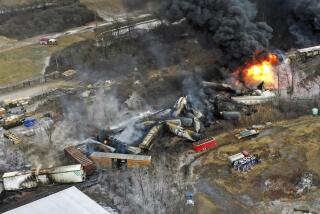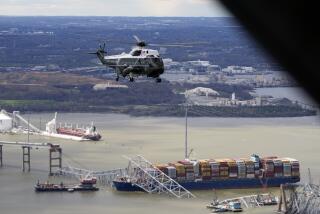A look at the worst bottlenecks on the Northeast Corridor
NEWARK, N.J. — As state and federal officials look for an estimated $15 billion for a new train tunnel between New York and New Jersey, passengers along the rail line known as the Northeast Corridor contend with regular disruptions caused by track configurations and infrastructure dating to the time of the Model T — or earlier.
These antiquated structures, which will cost billions to replace or upgrade, conspire to slow train travel in a variety of ways. They can limit the number and speed of trains that pass through at a given time, and aging parts can lead to malfunctions when bridges open to allow boats to pass under. Regular maintenance can be costly and time-consuming.
With Congress reluctant to fund major rail projects and states unable to foot the bills themselves, it paints a bleak picture for the Northeast Corridor, the nation’s busiest rail line, where annual passenger trips on Amtrak and eight commuter lines, currently at 260 million annually, are projected to double by 2040.
“It’s one of those things that when it happens, it really is scary,” Connecticut Department of Transportation Commissioner James Redeker said, referring to when one of his state’s aging bridges malfunctions. “There is no alternative. There’s no option for that. When it opens and it doesn’t shut, the whole Northeast corridor is shut down.”
Talk of how to pay for a tunnel under the Hudson River, which the governors of New York and New Jersey have asked the federal government to help pay for, has gotten the most media coverage. A look at some of the other big bottlenecks along the Washington-to-Boston line:
___
BALTIMORE & POTOMAC TUNNEL, BALTIMORE
Built eight years after Robert E. Lee surrendered at Appomattox, its age and design force the roughly 140 trains that go through it each day to slow from 60 mph to 30 mph and go from four tracks to two. Due to the constant intrusion of water into the concrete slab underneath the tracks, Amtrak has had to partially close the tunnel for repairs twice in the last 18 months, causing significant delays.
Major improvements are years away. A $60 million federally funded study looking at different options won’t be finished until mid-2017. A new tunnel could cost at least $1.5 billion, according to Amtrak.
Clo Harvey, a Brandywine resident who works in Baltimore, said she was more concerned about safety, particularly in the wake of the May derailment of an Amtrak train in Philadelphia that killed eight people and injured more than 200. But she said a new tunnel isn’t the only pressing infrastructure need in the region.
“To have a new one just to satisfy people to say that, you know, we have a new tunnel, then no, because just seeing different things around Baltimore, especially their streets, things need to be done there,” she said. “The streets are horrible, just for driving purposes.”
___
SUSQUEHANNA and BUSH RIVER BRIDGES, MARYLAND
Both date to the first decade of the 20th century and require crews of workers to manually crank the bridges open and shut to accommodate marine traffic.
A $22 million engineering study of the Susquehanna River bridge will be completed in 2017. Among the options is a two-bridge system with one bridge used primarily for passenger trains and the other for freight trains. The Bush River Bridge is awaiting funding for preliminary engineering and environmental analysis; replacing the half-mile span could cost about $400 million and is at least 10 years off, according to an Amtrak spokeswoman.
___
PORTAL BRIDGE, KEARNY, NEW JERSEY
Long the bane of commuters, the 105-year-old swing bridge over the Hackensack River opens periodically to allow boats to pass through. Problems at the bridge contributed to more than 200 delays between the beginning of 2013 and mid-2014, according to commuter rail operator New Jersey Transit.
Amtrak has restricted trains to 60 mph on the bridge (compared to 90 mph for approaching tracks) since a 1996 derailment. In 2005, overhead power lines came down, starting a fire on the bridge that caused backups lasting nearly 10 hours.
Design and engineering work has been completed for the first of two new bridges that would be high enough for boats to pass under, but about $1 billion is needed to build it. The bridge is part of Amtrak’s Gateway project, which also includes a new Hudson River tunnel and expanded Penn Station in New York.
“Portal is like the tunnel; it’s not going to fail tomorrow,” said Drew Galloway, Amtrak’s chief of planning and performance on the corridor. “Structurally it’s OK, but electrically and mechanically, it’s beyond its useful life.”
___
CONNECTICUT BRIDGES
The nearly 110-year-old Connecticut River bridge along the coastline between Old Saybrook and Old Lyme stays open for marine traffic but closes when trains approach. That happens about 3,000 times per year, Galloway said, and that gradually wears down the pins and bearings that allow the bridge to move and then lock in place.
An environmental assessment by the Federal Railroad Administration last year concluded “the operational reliability of the aging bridge results in cascading delays to rail and maritime traffic due to its failure to open and close properly.”
In addition, the bridge’s nine stone masonry piers “don’t come close to meeting modern-day seismic standards,” Galloway said. “No one cared about earthquakes in the East, until one happened a couple of years ago.”
Amtrak estimates replacing the bridge would cost $300 million.
Farther south, the Devon Bridge spanning Stratford and Milford, built in 1905, needs to be replaced at a cost of nearly $1 billion, according to state officials.
The 119-year-old Walk Bridge in Norwalk offers a more encouraging scenario: The state received $161 million in federal funding last year to help replace the span, which had become stuck open a couple of times, causing major delays. It’s expected to cost about $460 million to replace and will take about four years. The actual structure will be built elsewhere and then moved into place, state officials said.
In the meantime, the state has replaced and repaired some of the bridge’s parts, including specialty rollers that had to be fabricated from scratch because they can’t be ordered. There have been no problems since then, Redeker said.
Train troubles are relatively uncommon in eastern Connecticut, but any delay farther south toward New York can have a ripple effect throughout the region, said Jill Billiau, of Old Saybrook, as she waited for a train there recently.
“You have to go early enough so they don’t affect you,” she said.
___
CURVES AND NARROWS
May’s derailment at a junction just north of central Philadelphia highlighted the role tracks play in limiting train speed. The accident occurred on a curve that is one of the sharpest on the corridor, where trains are required to slow to 50 mph.
Galloway noted that bridges and tunnels aren’t the only places on the corridor where four tracks are reduced to two, limiting the number of trains that can operate. For example, he said, on a 7-mile stretch in northeastern Maryland, Amtrak and commuter trains use two tracks in an area where slow-moving oil trains also operate.
A long-term federal transportation study on the Northeast Corridor updated in August identified more than a dozen locations where smaller projects could be undertaken to reduce congestion at chokepoints. These included adding or extending platforms, reconfiguring tracks and improving train yard access.
___
Contributing to this report were Associated Press writers Susan Haigh in Hartford, Connecticut; Stephen Singer in Old Saybrook, Connecticut; and Brian Witte in Baltimore.
Copyright 2015 The Associated Press. All rights reserved. This material may not be published, broadcast, rewritten or redistributed.
More to Read
Sign up for The Wild
We’ll help you find the best places to hike, bike and run, as well as the perfect silent spots for meditation and yoga.
You may occasionally receive promotional content from the Los Angeles Times.






